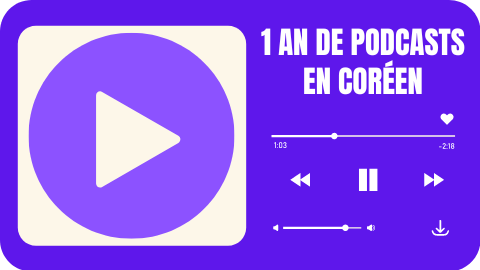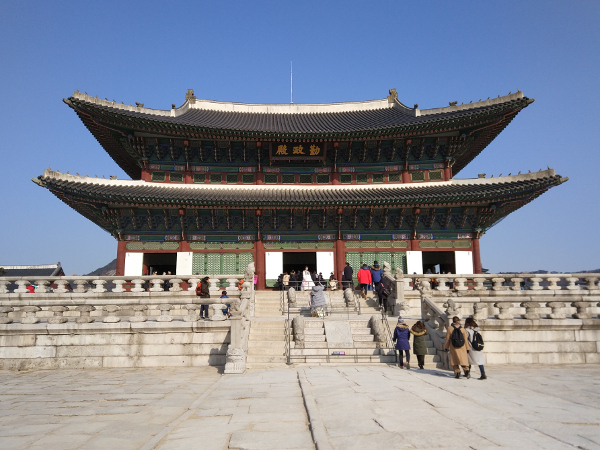Cours de coréen ᚛ Level 1 - My First Steps in Korean (Lessons 1 to 30) ᚛ Leçon 25 - Past tense conjugation in Korean [-았/었어(요)] [-았/었습니다]
Past tense conjugation in Korean [-았/었어(요)] [-았/었습니다]
In a previous lesson, we learned how to conjugate Korean verbs in the present tense. Mastering this is essential to be able to conjugate Korean verbs in the past tense.
The past tense in the casual style in Korean
Conjugating verbs in the past in the casual style is done as follows:
[Verb conjugated in the present tense]ㅆ어
The verb 살다 (= to live) has a stem 살 which contains a ㅏ, so we add 아 to the stem to get its present form in the casual style: 살아. From this form, we add ㅆ어 to get the past tense.
- 살다 → 살았어. = I lived. / You lived. / He lived… etc.
The verb 먹다 (= to eat) has a stem 먹 which contains neither ㅏ nor ㅗ, so we add 어 to the stem to get its present form in the casual style: 먹어. From this form, we add ㅆ어 to get the past tense.
- 먹다 → 먹었어. = I ate. / You ate. / He ate… etc.
과일을 씻었어.
→ I washed the fruit.
나는 밥을 먹었어.
→ I ate (a meal).
The past tense in the polite style in Korean
Conjugating past tense verbs in the polite style consists of taking the form of the casual style and then adding the polite suffix 요, as follows:
[Verb conjugated in the past in the casual style]요
The verb 알다 (= to know) has a stem 알 which contains a ㅏ, so we add 아 to the stem to get its casual style present form, 알아, then ㅆ어 to get its casual style past form, 알았어. From there, we get the polite past tense by adding the polite suffix 요.
- 알다 → 알았어요. = I knew. / You knew. / He knew… etc.
The verb 읽다 (= to read) has a stem 읽 which contains neither ㅏ nor ㅗ, so we add 어 to the stem to get its present form in the casual style, 읽어, then ㅆ어 to get its past form in the casual style, 읽었어. From there, we get the polite past tense by adding the polite suffix 요.
- 읽다 → 읽었어요. = I read. / You read. / He read… etc.
열쇠가 있었어요.
→ I had the key.
어제 바람이 많이 불었어요.
→ Yesterday the wind blew a lot.
Conjugation exceptions in Korean past tense
All the conjugation exceptions seen in the Korean present tense lesson for the casual and polite styles apply to the past tense. Regardless of the exception, the construction of the past is always done as follows:
[Verb conjugated in the present tense]ㅆ어(요)
The verb 가다 (= to go), verb in ㅏ, has an irregular conjugation, 가 in the present casual style. We add ㅆ어(요) to get its past tense form.
- 가다 → 갔어. (casual style) / 갔어요. (polite style) = I went. / You went. / He went… etc.
The verb 하다 (= to do) has an irregular conjugation, 해 in the present tense casual style. We add ㅆ어(요) to get its past tense form.
- 하다 → 했어. (casual style) / 했어요. (polite style) = I did. / You did. / He did… etc.
The irregular verb 춥다 (= to make cold), verb in ㅂ, has an irregular conjugation, 추워 in the present casual style. We add ㅆ어(요) to get its past tense form.
- 춥다 → 추웠어. (casual style) / 추웠어요. (polite style) = It was cold.
En savoir +
Past tense in formal style in Korean
Conjugating Korean verbs in the past tense in the formal style is done as follows:
[Verb conjugated in the present in the casual style]ㅆ습니다
The verb 닦다 (= to clean) has a stem 닦 which contains a ㅏ, so we add 아 to the stem to get its present form in the casual style, 닦아, then ㅆ습니다 to get its past form in the formal style.
- 닦다 → 닦았습니다. = I cleaned. / You cleaned. / He cleaned… etc.
The verb 없다 (= not to exist / not to have) has a stem 없 which contains neither ㅏ nor ㅗ, so we add 어 to the stem to get its present form in the casual style, 없어, then ㅆ습니다 to get its past form in the formal style.
- 없다 → 없었습니다. = I didn’t have. / You didn't have. / He didn’t have… etc.
민지는 숙제를 했습니다.
→ Minji did her homework.
에어컨이 고장났습니다.
→ The air conditioner broke down.
Past Infinitive and Past stem
En savoir +
The verb 이다 (= to be) in the past tense
En savoir +
Special uses of the past
En savoir +
Summary table of structure
En savoir +
Exercises
En savoir +
1 an de podcasts en coréen est un ensemble de plus de 50 podcasts en coréen présentés par des Coréens natifs.
Vous étudiez le coréen depuis un certain temps mais la compréhension orale reste encore difficile pour vous ? Malgré vos connaissances en grammaire et en vocabulaire, vous n’arrivez pas à comprendre les vidéos ou les dramas coréens, ainsi que les natifs qui vous parlent ?
Les podcasts sont un excellent moyen d’améliorer sa compréhension orale car ils permettent de se concentrer sur des contenus audios clairs et articulés, tout en mettant en relation toutes les connaissances acquises en coréen depuis le début de votre apprentissage. Un véritable exercice formateur qui permet d’améliorer grandement votre niveau en coréen.
En savoir +

